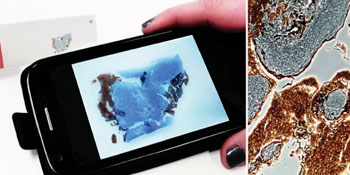Polymer-Based Rapid Test Visually Differentiates Tumor Cells
By LabMedica International staff writers
Posted on 19 Jan 2016
A polymer-based rapid test has been developed which visually differentiates tumor cells from healthy cells in a tissue section through the use of a simple microscope. Surgeons can already use the test in the operating room which saves time and expenses. Posted on 19 Jan 2016
Antibodies combat viruses and bacteria and they also attach themselves to cancer cells in a typical, characteristic way. This property has been used to detect cancer cells in tissue samples and such rapid tests can already be applied by surgeons during operations, within a few minutes and without expensive equipment.

Image: A cell phone camera is sufficient to examine tissue samples for tumor cells (Photo courtesy of Fraunhofer IAP).
Scientists at the Fraunhofer Institute for Applied Polymer Research (IAP; Potsdam, Germany) have developed a polymer-based rapid test which visually differentiates tumor cells from healthy cells in a tissue section through the use of a simple microscope. Surgeons can already use the test in the operating room. This saves time and expenditures. Studies have shown that receptors sit on tumor cells, and certain specific antibodies attach to these receptors: for example, estrogen antibodies on breast carcinomas. Using this "immunodiagnostic" method, the surgeon only needs a few minutes to make sure that all the diseased tissue has been removed. Once placed on the tissue sample, the antibodies search independently for their counterpart, the receptors, which are distinctive for them.
For reasons of reliability, a cross test characteristically dyes the healthy cells in the next step. Once neither of the two tests detects any more tumor cells, the surgeon can conclude the operation as he has cut out all of the diseased cells. The scientists are working to make the color contrasts between healthy and diseased tissue cells more clearly visible. Joachim Storsberg, PhD, head of department Functional Polymers for Medical Technology, said, “Locating tumors accurately in tissue sections is not easy. It's easy to distinguish diseased from healthy tissue at the core of the cancerous ulcer, but not around the edges: tumors spread out asymmetrically.”
Related Links:
Fraunhofer Institute for Applied Polymer Research













